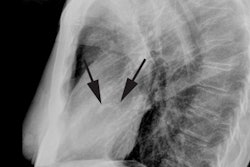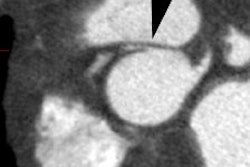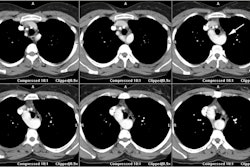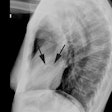Aortic Incompetence:
Clinical:
Etiologies of aortic insufficiency include: Rheumatic heart disease (most common cause), aortitis (Syphilus), ascending aortic aneurysm with aortic root dilatation (Marfan's), myxomatous degeneration of the valve (Marfan's), or a dissecting aneurysm involving the valve ring. Aortic incompetence may also complicate AS secondary to a bicuspid valve or follow an episode of infective endocarditis.Aortic regurge causes a volume overload in the LV [12]. Pressure overload is also a factor because a larger LV volume leads to higher wall stress [12]. Findings in AI include a collapsing pulse (often with a low diastolic pressure [40 mm Hg]) and a diasystolic murmur. AI generally progresses in a slow fashion during a long asymptomatic period. Progressive left ventricular enlargement and hypertrophy occur commensurate with the degree of regurgitant flow. Vasodilator therapy during this period can reduce the hemodynamic burden on the LV. Eventually, the stretching capacity of the left ventricle exceeds a critical limit and the ventricle fails with resultant decrease in ejection fraction. When this occurs, there is often a suboptimal response to valve replacement surgery, although patients will generally still derive some benefit. In fact, good surgical results can still be expected if the duration of LV dysfunction was less than 14 months.
A regurgitant fraction below 30% is considered mild AI, between
30-49% moderate AI, and equal to or greater than 50% severe AI [3]. In
general, asymptomatic patients with only minimal LV enlargement
(end-diastolic
dimension under 60 mm) and normal systolic function, rarely require
valve
replacement. Asymptomatic patients with LV enlargement and a normal
ejection
fraction at baseline require valve replacement at the rate of about 4%
per year. If the cardio-thoracic ratio is greater than 60% there is
increased
post-operative morbidity and 5 year survival is significantly lowered.
Accepted indications for aortic valve replacement in AI include severe
aortic regurge (reguritant volume equal or greater than 60 ml per beat
or regurgitant fraction equal or greater than 50%) AND symptoms
referable to the AI or evidence of LV dysfunction (LVEF < 55%) or LV
enlargement (end-systolic diameter equal or greater than 25mm/m2
body surface area) [3].
Overall, surgical mortality from aortic valve replacement surgery is under 3% when patients have no associated coronary artery disease.
X-ray:
On CXR there is left ventricular enlargement, tortuosity of the descending aorta, and mild dilatation of the ascending aorta. The presence of an enlarged, tortuous ascending aorta of indicates that the regurge is secondary to ascending aortic pathology that has resulted in dilatation of the aortic valve annulus or loss of aortic valve suspension. Cine MR can be used to demonstrate the regurgitant diastolic jet extending into the left ventricle.REFERENCES:
(1) Chest 1997; Managing asymptomatic patients with chronic aortic regurgitation. 111: 1702-09 (no abstract available)
(2) Radiologic Clinics of North America 1999; Lipton MJ, Coulden R.
Valvular heart disease. 37(2): 319-339
(3) Radiographics 2012; Bennett CJ, et al. CT and MR imaging of the aortic valve: radiologic-pathologic correlation. 32: 1399-1420






